Shopify Store Tutorial for Beginners: How to use Shopify

What bridges your eCommerce business with your customers? The answer is “an eCommerce website”. Or you can also call it an online store. There are different eCommerce platforms available that help you create your online stores.
But today we will learn about the Shopify platform!
Shopify is a great platform for entrepreneurs and small businesses looking to build a fully functional online store without technical knowledge. It’s simple to use, affordable and packed with useful features that can help you build your online business.
If you are new to Shopify, this guide is for you. This Shopify tutorial will help you learn how to create a successful eCommerce store with Shopify.
Let’s begin the read!
What Is A Shopify Store?
A Shopify store is an eCommerce website that builds using the Shopify platform that lets you sell your products and services online. You can use it to build your own eCommerce platform or to sell items through the site of another company.
Is Shopify good for beginners?
Shopify is a great choice for beginners because it has an easy-to-understand interface and a growing list of free Shopify apps or plugins that make it easier to set up and manage your Shopify site.
These are especially helpful if you’re starting out with no experience at all in online selling.
Are Shopify Stores Safe?
Yes, Shopify Stores are safe! They are hosted on secure servers, protecting your customer data from hackers. Again Shopify uses SSL technology. This means that all your data will be encrypted when it’s sent over the internet.
Shopify also keeps your online store secured from fraudulent orders by its standard fraud protection analysis.
However, there are also ways to lower the overall risk level by using certain third-party Shopify maintenance services that can help you improve your store downtimes and boost customer experience.
What’s next in the Shopify tutorial?
Main Benefits Of Creating A Shopify Store
Shopify is a great platform for business owners who want to build their own eCommerce website. Here are some of the main benefits of setting up a store on Shopify:
Ease of use
The user interface is straightforward and easy to navigate. You don’t need any technical knowledge or experience with coding.
Quick Setup
With Shopify, you can create a fully working online store in less than 60 minutes. You just need to follow the setup guide in the Shopify Admin wizard, and you are all set to sell online.
Flexibility
Shopify offers multiple payment gateways, including PayPal, Stripe, and Amazon Pay. Nowadays, you can also have a super personalized storefront with Shopify Headless with Hydrogen.
Customization
You can easily customize the look of your store using the best Shopify themes from their theme store. This includes free and paid themes based on your store requirements.
Before you start building your store with Shopify, make sure you have determined what type of store you want to own.
Let’s explore some common types of Shopify stores in this Shopify tutorial.
Types Of Shopify Stores You Can Build
The Shopify eCommerce platform can be used for both physical and virtual stores. It offers massive customization options no matter which type of store you create with Shopify.
Here are the common types of online stores merchants can have on Shopify:
Dropshipping Store
The dropshipping store is a great way to start selling online without having to worry about managing inventory or shipping orders. Dropshipping stores are typically built on the Shopify platform, so you can easily set up your shop in minutes and start selling online immediately.
This is a store that sells products from multiple suppliers and then ships them directly to customers.
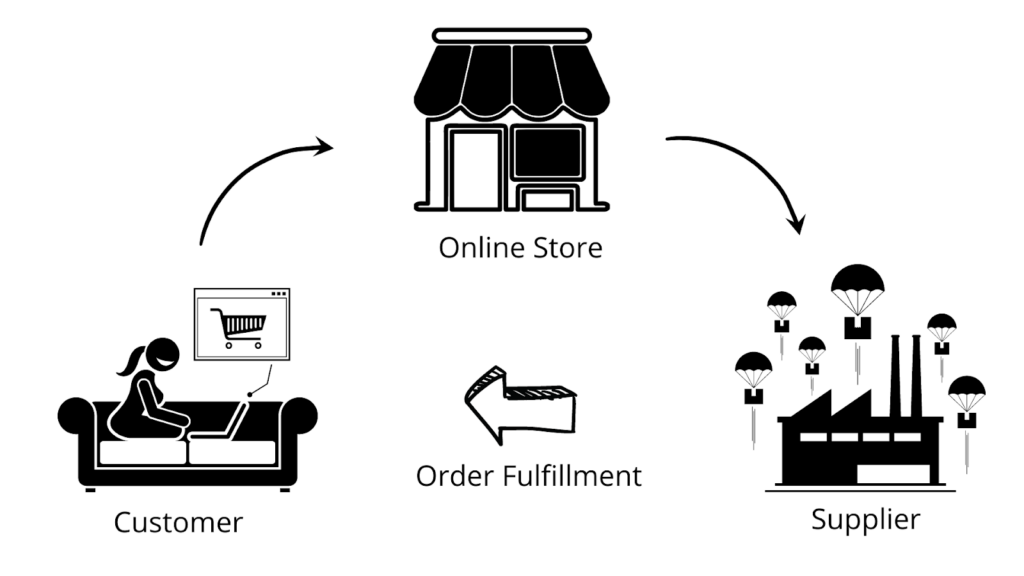
Single-Product Store
If you’re looking for a simple way to sell just one product at a time, then the single-product store might be the perfect fit for you. This type of store has the advantage of not managing a large product line since the seller only needs to ship one product at a time and keeps everything else in stock until they’re sold out.
Niche Store
Niche stores are focused on specific categories, such as fashion, home décor, health products, etc., rather than selling everything under one umbrella category like most online stores do today.
Niche shops appeal to people who are looking for something specific in the market and have narrow tastes when it comes to selecting products they want to buy.

Hybrid Store
A hybrid eCommerce store is a combination of a store with an offline version. Hybrid stores offer the convenience and flexibility of an online store with the profit potential of an offline shop.
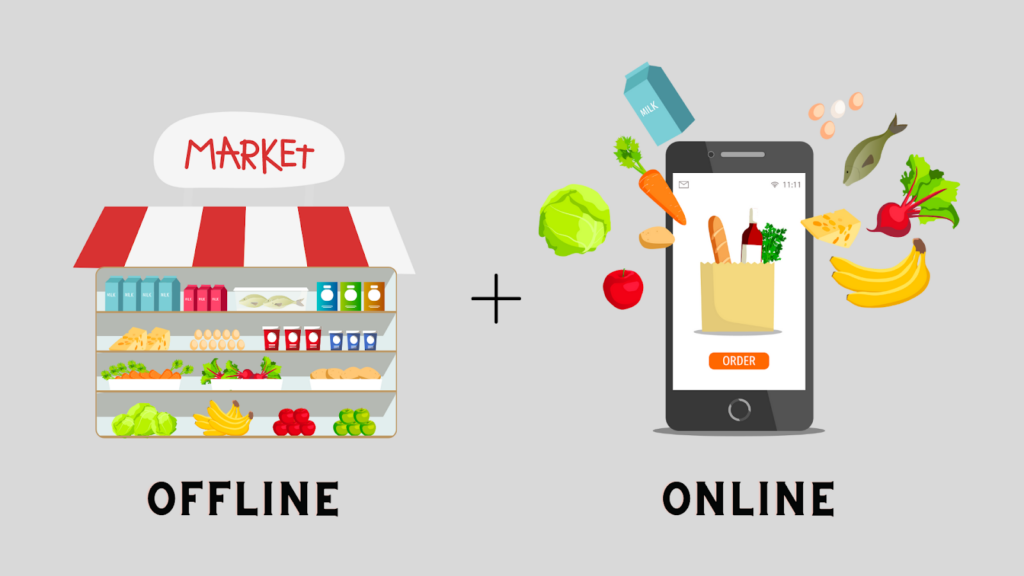
This means that you’ll have an online store with some physical products (such as books) that you can ship from your warehouse, but also have the ability to sell other products directly from your website.
General Store
This type focuses on selling a wide variety of products. You can use this type of store if you have a large number of product categories, and want to focus on selling those items all at once!
For example, Walmart, Amazon, Flipkart, etc.
In a nutshell, Shopify is not just for big brands — it’s also great for small businesses looking to build their online business with all the basic functionality.
After learning Shopify basics in this Shopify tutorial, now it’s time to create your first eCommerce website with Shopify.
Let’s learn how to get your online store ready in no time.
How To Use Shopify To Create Your Online Store

If you’re new to Shopify, you can use this process to get your store up and running. It’s easy and takes only a few minutes.
Here’s how to use Shopify to create your eCommerce website:
- Setting Up Shopify Account
- Add Products And Collections
- Pick a Shopify Theme
- Customize Your Shopify Store
- Add Necessary Pages
- Setup Your Store Navigation
- Connect Your Domain
- Add Payment Gateways
- Set Up Shipping & Delivery Methods
Let’s walk through each step in detail…
1. Setting Up Shopify Account
Before you can create a store, you’ll need to set up your account. You can do this quickly by following these steps:
- Sign up for a Shopify account at Shopify (If you already have one, skip to step 2.)
- Enter all your business information like your name, email address, store name, and store category. Make sure that everything is correct before proceeding any further.
- Specify the store location and time zone.
- Choose a Shopify plan that fits your needs (i.e. Basic Shopify plan, Shopify, and Advanced plan).
This will create your online store automatically and take you to your Shopify admin.
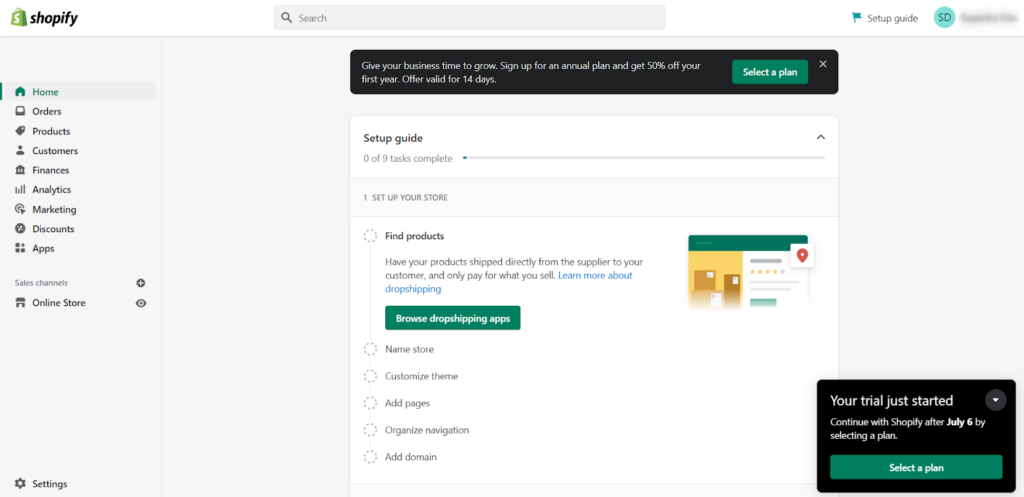
For most the merchants wondering whether they can create multiple stores with one Shopify account — You can create only one store with one Shopify account.
Note: Until you make your Shopify store live, you can make it password-protected by adding storefront passwords to your online store.
2. Add Products And Collections
There are multiple ways you can add products or inventory to your store.
- Import products — If you have a large number of products, you can upload the products in bulk using the “Import products by CSV” option. Make sure you organize your product data based on the predefined format given in the sample CSV template.
- Add products manually — Click on the “Add product” button and fill in all the product information manually including media and variants.
- Add products via Dropshipping App — If you creating a Shopify dropshipping store or have a common product line, then you can import products directly from any dropshipping Shopify apps like Oberlo or DSers.
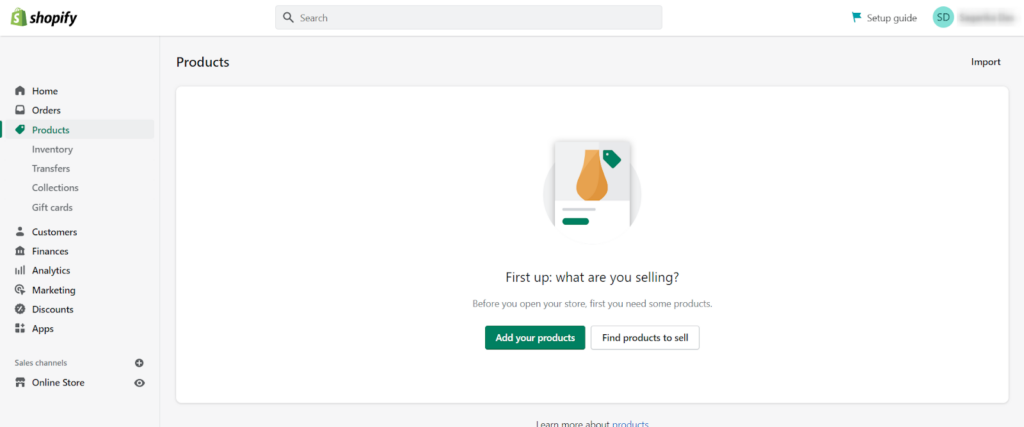
After adding the products, you can categorize them using Shopify Collections. Simply create different collections and add similar products to them.
This will help you show all the similar products in one place.

3. Pick a Shopify Theme For Your Store
Now, you need to choose a Shopify theme for your store, which is the look and feel of your website. There are hundreds of free themes and premium themes available in the Shopify theme store [3].
Therefore, it is important that you find one that best suits your needs.
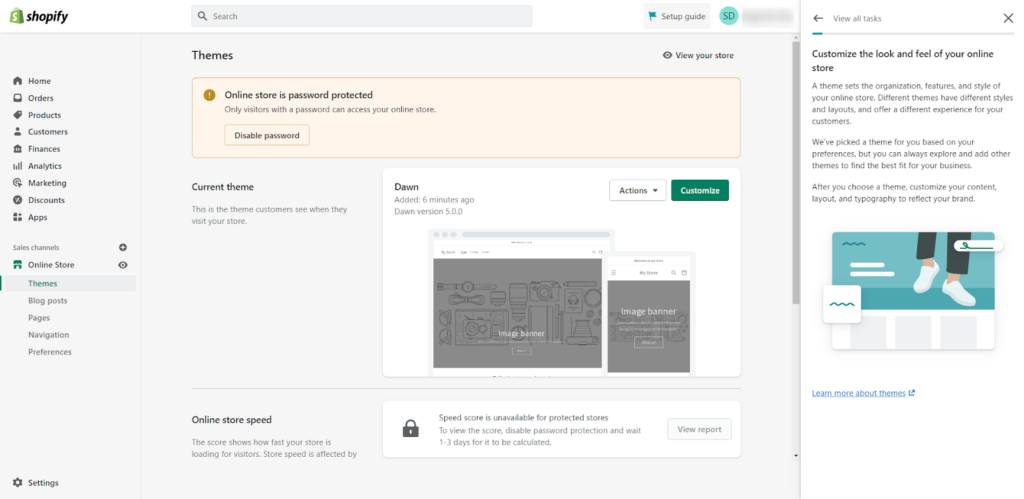
If you need more customization options with additional features like a product recommendation, metafields support, product filters, and many more, you should consider using the Shopify 2.0 themes for your store.
4. Customize Your Shopify Store
Once you have selected the best-suited Shopify theme for your store, now it’s time to customize the theme with Shopify sections and blocks. Here’s how you can do that:
- Prepare your website header and footer
- Add sections to your homepages like image banners or slideshow, featured products or collections, rich content, multi-columns, etc.
- Customized the product pages and the collection pages.
- Use the theme settings to modify the style, color, size of text, and background of your store theme.
- Add social media page links to your Shopify store.
- Install necessary Shopify apps from the Shopify app store to extend your store functionality.
Shopify theme customization is a very important step while creating a store because it decides whether your store is professional/trustworthy or not.
If you find it challenging, you can hire Shopify experts who can help you with proper Shopify theme customization for your store.
5. Add Necessary Pages To Your Online Store
It would be difficult for new shoppers to trust a newly launched eCommerce brand for the purchase. Therefore, you have to make sure your online store has everything that can boost user trust.
Thus, before you make your first Shopify store live, ensure your online store has all the necessary pages such as,
- About Us page,
- Contact page,
- Terms & Conditions page,
- Shipping page,
- Return policy page, and so on.
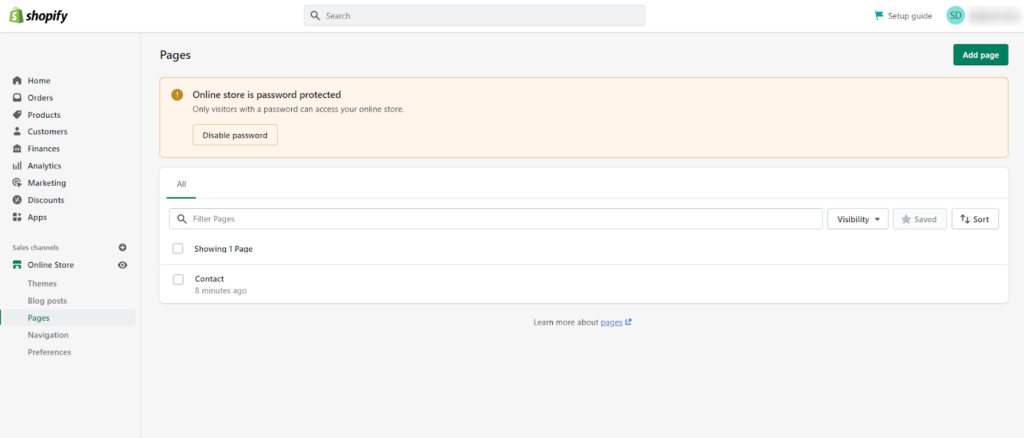
Creating new pages in Shopify is easy! First, you have to add a new page from Online Store > Pages. Then, you can add the page template using the theme editor for your Shopify themes.
6. Setup Your Store Navigation
To offer a great shopping experience to your store visitors, you need to make sure the site navigation is simple and all the pages are easily accessible. Organize the header menu in a way that your main page shows up first at the top.
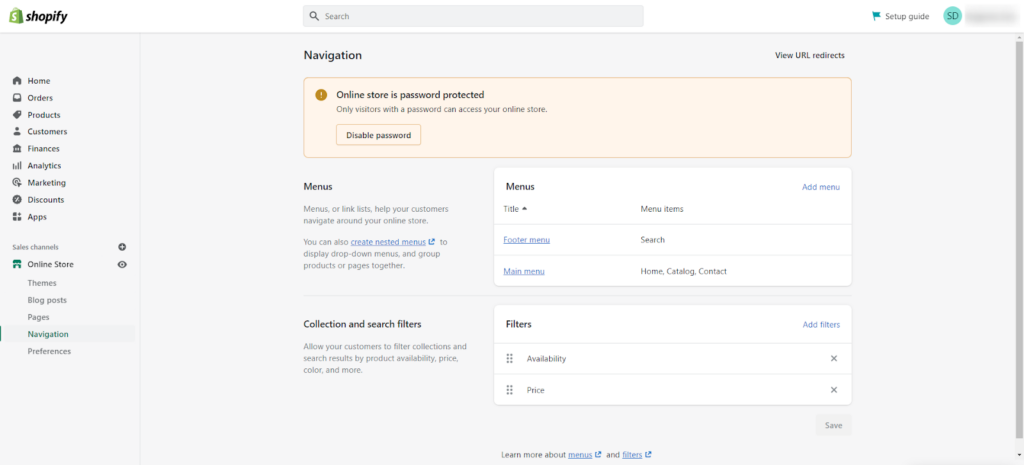
If you have more links to add to the header, you can use the drop-down menu [5] by building nested navigation in the Shopify store. In the same way, you can set up the footer menu for your Shopify website from Online Store > Navigation page.
If you need help with Shopify store setup, our Shopify experts would love to get your dream store ready to launch.
7. Connect Your Domain To Your Shopify Store
Once you complete account setup, you can see your online store Shopify link on the address bar. By default, the Shopify store name you provide becomes the primary store domain for your website. Its format is “www.storename.myshopify.com”.
You may wish to change the default store name or URL and connect the custom domain name to your store.
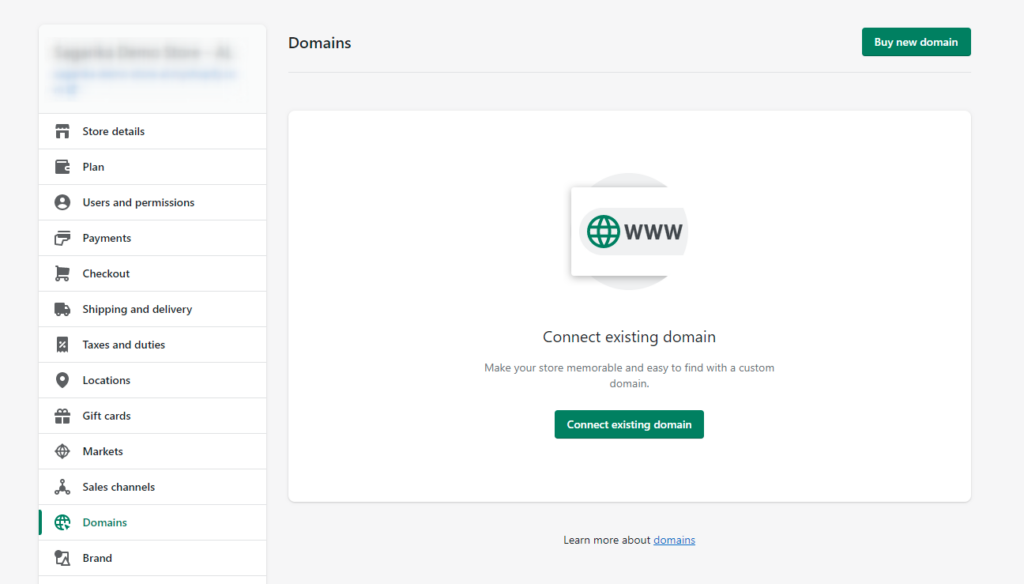
Go to Shopify settings > Domains, then connect your existing domain or buy a new domain for your store. After adding your custom domain, you can make it the primary domain name for your Shopify website.
8. Add Payment Gateway to Your Shopify Store
Before you start selling on your Shopify site, you need to add payment methods to your store. This is an important step, as it will allow your customers to make payments in their checkout process.
Using Shopify’s own payment gateway i.e. Shopify payments, you can avoid paying transaction fees. However. if you want to accept American Express or PayPal payments, you need to pay future transaction fees.
Shopify charges 2% payment gateway transaction fees if you are using payment gateways other than Shopify payments.

You can also allow your customers to make payments through their credit card, for which you have to make sure to enable the credit card gateway in your store.
9. Set Up Shipping & Delivery Methods
If you have multiple store locations, you can set up the shipping cost based on product weight as well as different zones or locations. You can make your store work on different delivery methods such as Shipping, Local Delivery, and Store Pick-up.
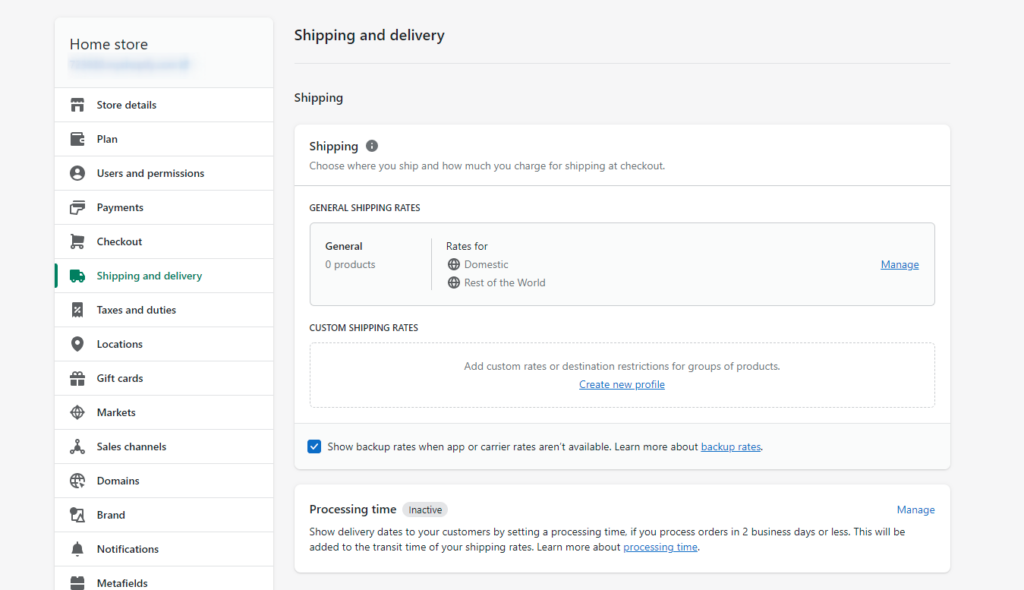
You can also avail of Shopify Shipping if your fulfillment location comes in the following countries:
- United States
- Canada
- Australia
- United Kingdom
- France
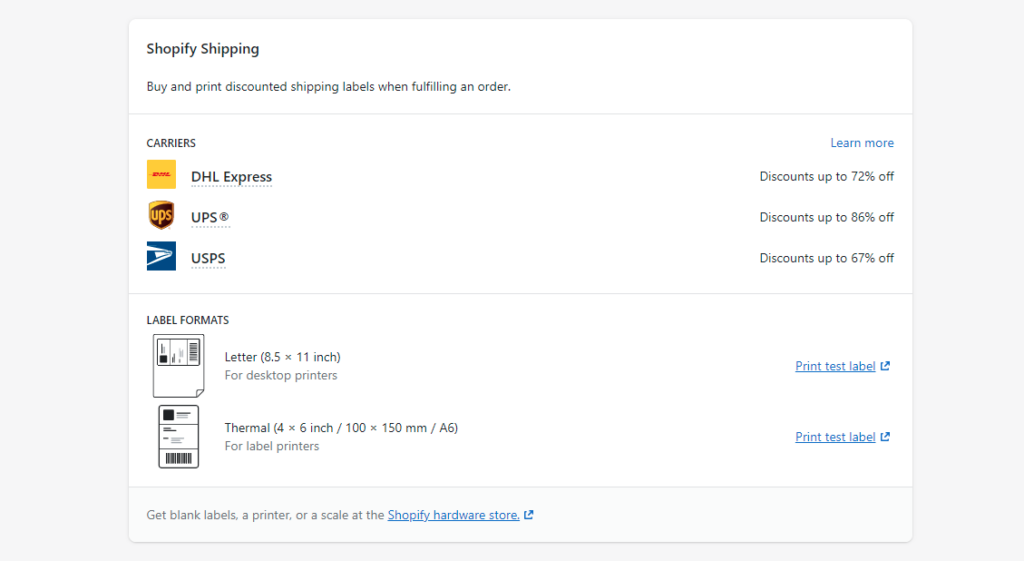
That’s it! This is how you can build your new Shopify store just in a few minutes.
How was your experience of creating your first online store with Shopify? Please share your experience with us in the comment box below.
Also, let us know if you are facing any difficulties in your first store build. We specialize in Shopify Store Development Services and have created 100+ successful online stores for our customers.
Let’s check what’s next in the Shopify tutorial.
Shopify Store Launch Checklist

Before you launch your first-ever store on Shopify, it’s important to verify if everything is fine to launch. Make sure you have covered all the points listed here in the Shopify Store Launch Checklist:
- Set up fast checkout with Buy buttons
- Include all possible sales channels
- Create discount codes for the launching Sale
- Double-check your payment gateways
- Set up your store’s default currency
- Make your regular pages
- Examine your email notification preferences
- Perform a content audit
- Make all of your website’s photos more optimized
- Set up an analytics tool like Google analytics
- Prepare a pre-launch marketing strategy
- Amend the tax and shipping settings if necessary
- Allow customers to contact you with ease
- Use only the necessary apps
- Add your billing information
- Test your store by placing some test orders
- Check the fraud analysis settings by Shopify
- Test your store for speed and performance
- Make sure your website is fully responsive
Once you are confident your Shopify store is all prepared for the first sale, you can make your store public by removing it from password-protected mode.
Need someone to check your store readiness??? Our Shopify store setup experts can help you!
Your work doesn’t end after launching your Shopify website!! That’s why our Shopify tutorial hasn’t ended yet. Next, we shall learn how to promote your Shopify site.
How To Get Free Traffic To Your Shopify Store
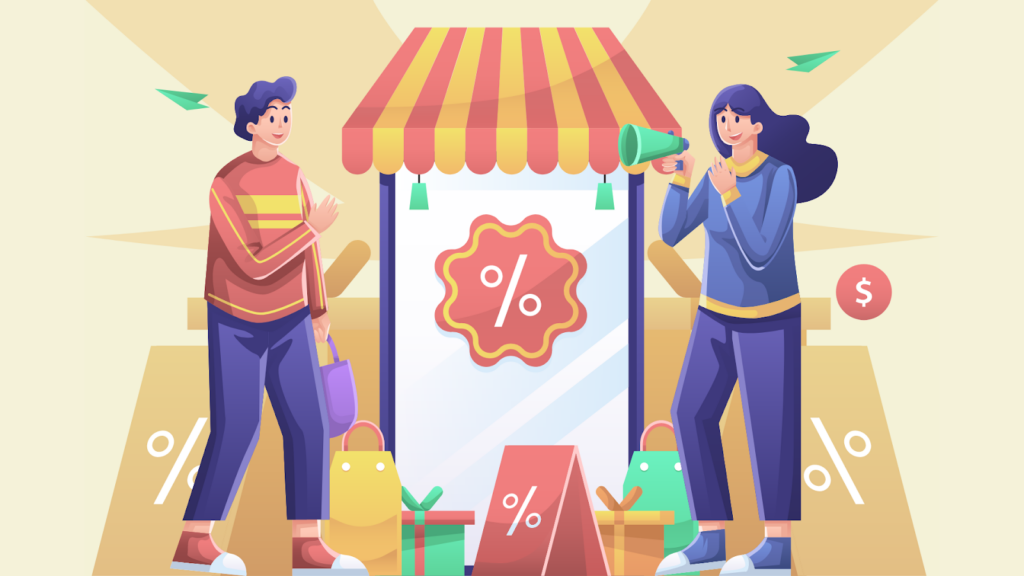
The first thing every merchant needs to focus on after launching their stores is getting traffic on their site. This requires continuous efforts in marketing or promotion of your store.
Here are some ways you can use to get free traffic to your online store.
1. Integrate Your Store With Various Sales Channels
To help you sell more, Shopify offers various integrations to Sales channels such as Google, Facebook, Pinterest, eBay, linkpop, and many more.
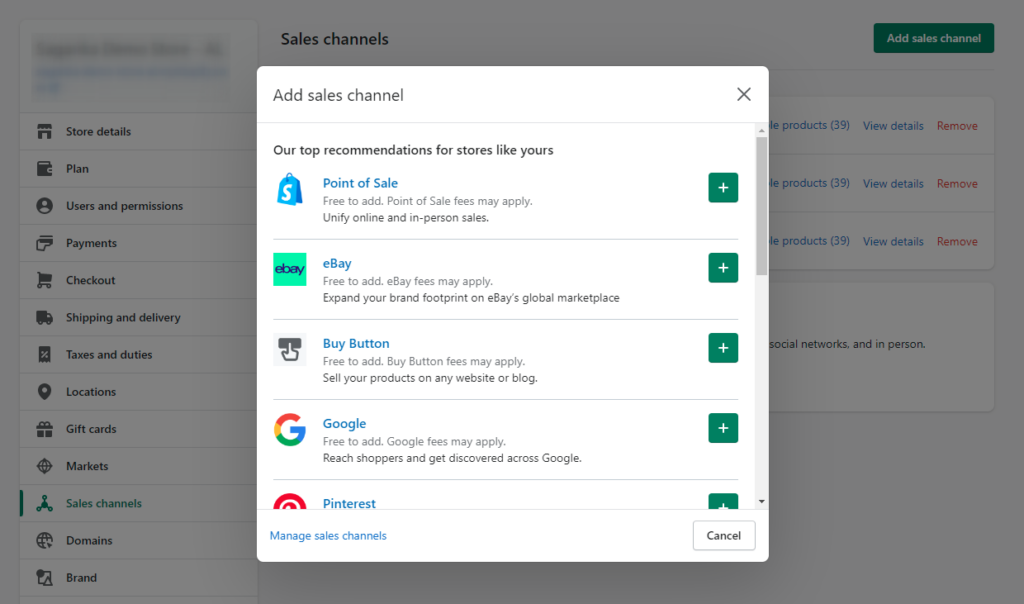
It’s good to have more sales channels which can help you get more visitors to your store. Go to Settings > Sales channels and add them to your store and promote your products on different platforms.
2. Optimize Your Shopify Store SEO
The first step to getting free traffic is to optimize your eCommerce store for search. The easiest way to do this is by optimizing every page of the site for search engines.
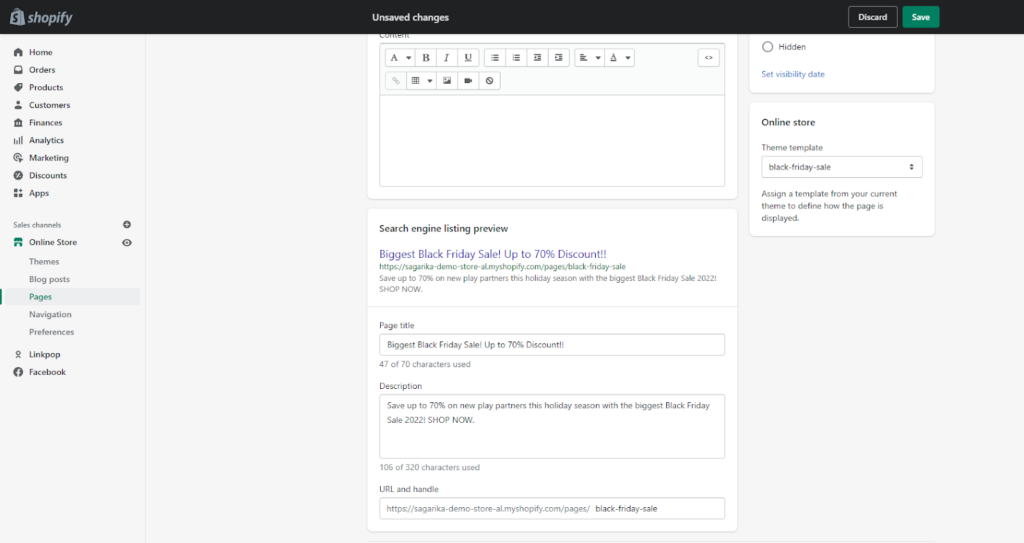
Shopify offers many ways to optimize the on-page SEO of your store which includes:
- Adding title and meta description to each page
- Adding image alt text
- Optimize the page URL
Some SEO best practices are:
- Write detailed descriptions on your product pages
- Include keywords in the content of Homepage, Blog posts, Products, Collections, and other pages
- Include the target keyword in the page URL and keep it short
- Add high-quality images and videos to your store pages
- Write short sentences and avoid long paragraphs
- Avoid duplicate content
- Structure your content with headings, numbers, bullet points
- Use descriptive file names
- Add internal links with right anchor text
If people search for products similar to those you offer, they’ll end up on your site instead of someone else’s. Therefore,
3. Publish Informational Content Using Shopify Blogs
Some of the most successful stores are those that offer educational content. A blog is a great way to deliver information on a topic you care about and want your customers to learn more about.
You can use your blog as an opportunity to share helpful resources and tips, or even provide an introduction to new products or services.
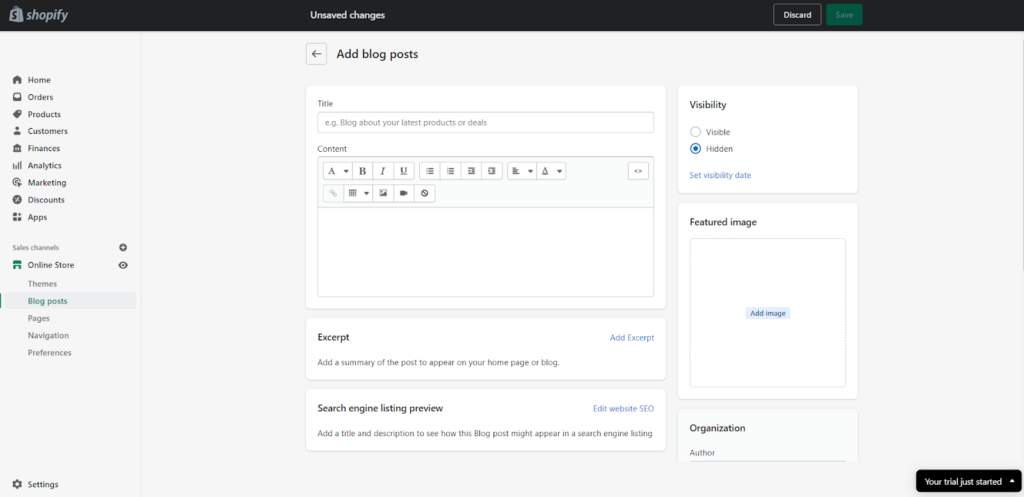
Here’s how it works:
- Go to Online Store > Blog posts.
- Set up a Shopify Blog module with blog categories.
- Add articles, images, and videos using Shopify’s built-in blog publishing tools.
- Add custom CSS styles and templates for each article so that they look consistent across all pages within the same store.
- Select a category to categorize your blog posts.
- Publish your article at an interval, i.e. weekly one or two.
This way using Shopify Blogging, you can provide value to your customers, in addition to selling them products and services.
If you’re not getting the traffic you want to your store, it’s probably because you have not implemented the marketing strategy in the right way.
Do you need the experts to make sure everything goes right? Share your pain points with our Shopify experts who can help your store with the best Shopify SEO and marketing services.
Shopify Tutorial Summary
If you’re looking to sell your products online, Shopify is the best platform to use. It’s easy to set up and has a wide range of products to choose from.
Shopify offers the fastest way to create your eCommerce website even if you are not a technical expert.
In this Shopify tutorial, you learn,
- Why Shopify is the best platform for your eCommerce business?
- How many types of eCommerce stores you can build with Shopify?
- How to use Shopify for creating your eCommerce website?
- Things to consider before launching your Shopify website.
- How to promote your store to drive traffic?
Hope this Shopify tutorial for beginners helped you in creating your own online store with all the basic functionality.






Post a Comment
Got a question? Have a feedback? Please feel free to leave your ideas, opinions, and questions in the comments section of our post! ❤️